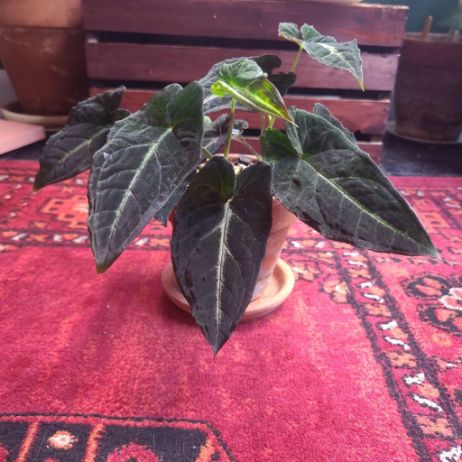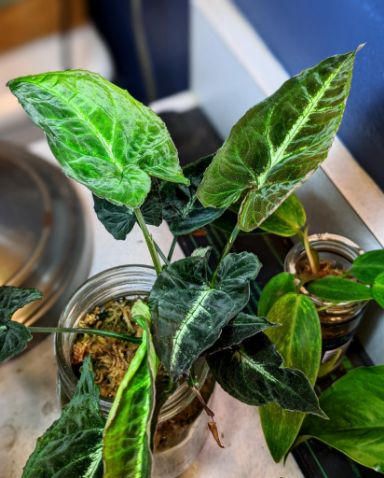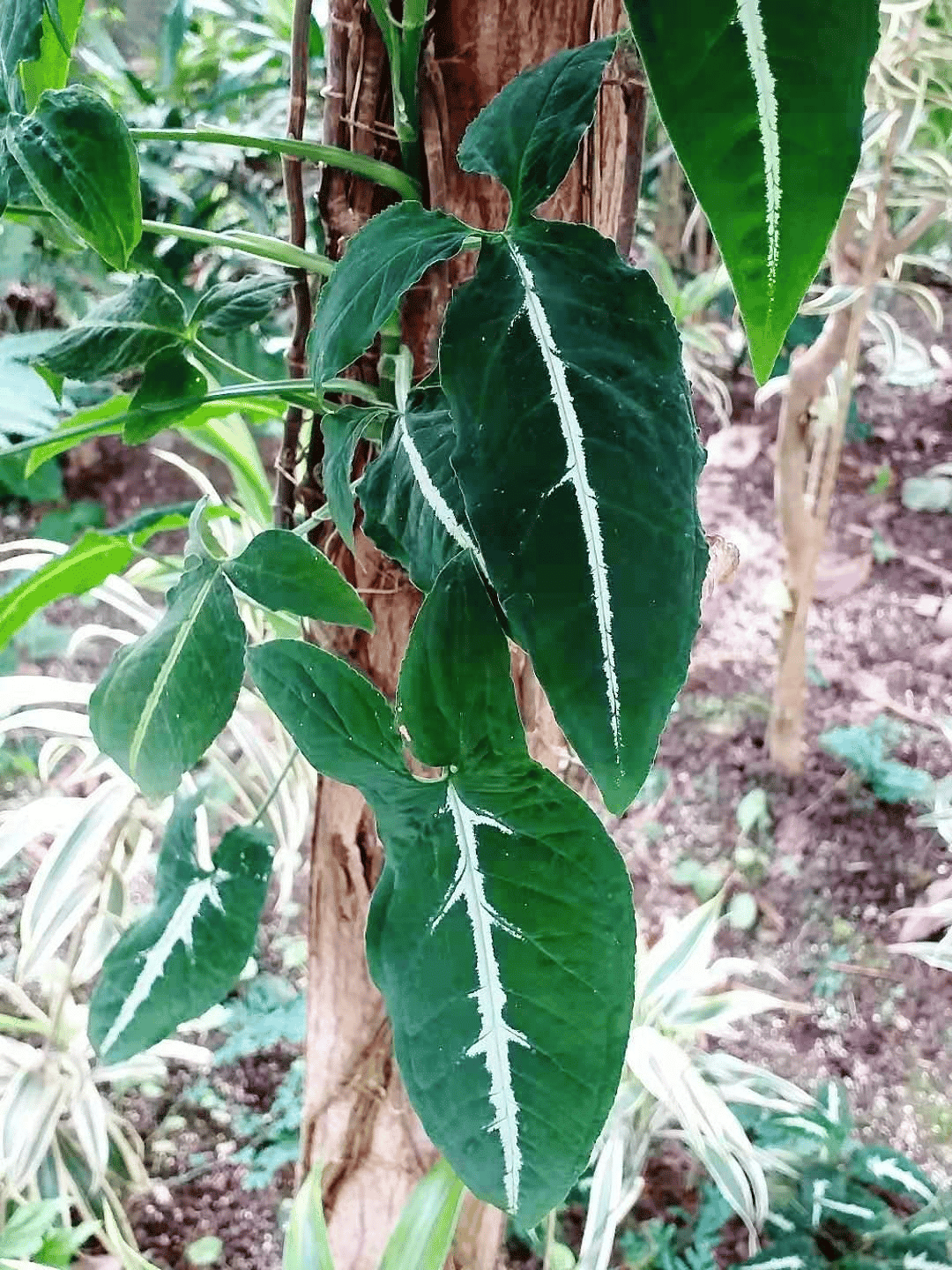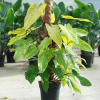With its alluring foliage and stark appearance, there’s no doubt that the Syngonium Rayii variegated is a head-turning houseplant. But believe it or not, there are a lot of things you need to know before you can grow a beautiful Rayii Syngonium by yourself.

Thank you for reading this post, don't forget to the best blogger Guy About Home who offers the best garden and home improvement tips! If you are a home decor and design fan, don't miss the tips on home ideas. If you are a home garden owner, then you might be interest in our complete guides to house plants!
Image Source: Reddit
The Syngonium Rayii, commonly known as the Velvet Syngonium, is a type of arrowhead due to the shape of its foliage. It is a notable tropical houseplant that can survive ambient temperatures. Because of this, this aroid plant became a popular choice among indoor gardeners. But just like other Syngonium variants, growing the Syngonium Rayii plant has requirements, as well.
Syngonium Rayii Informations & Facts
Here is the basic information about the Syngonium Rayii:
- Family – Araceae
- Genus – Syngonium
- Scientific name – Syngonium rayii
- Common name – Velvet Syngonium, Velvet Arrowhead
- Plant type – Indoor plant; decorative houseplant
- Origin – The Syngonium Rayii plant is a part of the Araceae family, which primarily consists of flowering plants. It is a native species of the South American and West Indies rainforests, specifically in Costa Rica and Panama.
- History – Similar to other Syngonium plants, the Velvet Arrowhead is a member of a flowering plant genus. There are approximately 30 variants of this plant, such as the Syngonium podophyllum, which is the most popular cultivated species of the plant.
Syngonium Rayii Variegated

Image Source: Reddit
A variegated Syngonium Rayii is quite stunning. Usually, variegating the plant would change the color of its foliage. You could achieve green-and-white combinations or something that is akin to silver, pink, or cream. If the plant is still young, the color of the leaves is typically solid green. In some cases, a mixture of cinnamon or cream could be spotted.
Syngonium Rayii Dark Form
The Syngonium Rayii Dark Form is considered the most beautiful form of the Rayii Syngonium. It has a dark, velvety appearance on its leaves while showing variegated stripes in the middle. The quality of the Dark Form is quite unique, making it a rare find, even for the most avid houseplant growers.
Syngonium Rayii Green Form
The Green Form of the Syngonium Rayii is actually its standard appearance. As mentioned, the foliage of the plant is green, while the middle features silvery stripes. Meanwhile, its overall texture is velvety, similar to the Dark Form. Hence, the difference between the Green Form and Dark Form is the “darkness” of their leaves.
Syngonium Rayii Runner
Interestingly, Syngonium Rayii can sprout a runner. You don’t have to worry about this since it can encourage new leaf growth. What you need to do here is to cut the runner and root the node in another pot or perlite box. Alternatively, you may also wrap the runner in a fern pole.
Syngonium Rayii vs. Wendlandii

Image Source: Wikipedia
Both the Rayii and Wendlandii plants belong to the Syngonium genus. These two are arrowheads due to the shape of their leaves. At the same time, their foliage has silvery stripes and a velvety texture.
Their primary difference are the following:
- Syngonium Rayii has darker leaves than Syngonium Wendlandii. Specifically, Wendlandii leaves are much greener.
- The leaves of the Rayii plant are small and not so elongated as compared to the foliage of Wendlandii.
Syngonium Rayii Mature: Things to Know
Here are some of the essential details about the mature Syngonium Rayii plant that you might not know yet.
Is Syngonium Rayii Variegated Rare?
Syngonium Rayii is actually a rare type of Syngonium plant. This is due to the stark, dark coloration of its foliage–much darker than its counterparts. So don’t get surprised if this plant is a little bit costly.
Speaking of rarity, what is the rarest Syngonium plant? The answer to this question can be subjective. But the Syngonium T25, also known as the Syngonium Dwarf Variegata, is touted to be among the rarest Syngonium plants due to its white leaves being translucent.
Not confident in planting an indoor plant? Why not getting power from our inspiring indoor plants quotes?
How Tall and How Big Does Syngonium Rayii Grow?
The Syngonium Rayii size may vary. But on average, the plant can grow as tall as 8 inches tall, so it is not actually a tall plant. Once it matures, its leaves will grow as long as 4 inches and as wide as 3 inches. Notable long vines can also be noticed as the plant starts nearing its maturity.
Is Syngonium Rayii a Fast Growing Plant?
Aside from being rare, the Syngonium Rayii is also a fast-growing plant, especially if it receives regular watering and nourishment. The figures aren’t exact, but its growth rate is the fastest during summer and spring.
Where to Place a Syngonium Rayii?
The proper placement of the plant is the key to its healthy growth and survival. Keep in mind that the Rayii Syngonium has a meager drought tolerance. So it would be best that you place it in an area where it receives indirect sunlight only. Either western or eastern exposure is allowed, but direct exposure is highly discouraged.
Syngonium Rayii Care Conditions & Requirements
In this section, you will learn the basics of Syngonium Rayii care.
In this section, you will learn the basics of Syngonium Rayii care. Specifically, this guide is suitable for Syngonium Rayii Dark Form care and Syngonium Rayii Green Form care. Hop on to learn more.
No worries! Though you might encounter the difficulties when learning how to care such an plant as a new plant caring starter, we got the most popular plant lover quotes that can partner with you and you are going to succeed in plant care and grow.
Besides this plant, we also make a full care guide on how to care for Trachyandra-tortilis.
Syngonium Rayii Light Requirement
As mentioned, it is deleterious for the plant to be exposed to direct sunlight. While it needs sunlight to survive, it isn’t durable enough to survive extreme heat. Ideally, the plant should only receive indirect sun exposure for at least four hours a day. For the Dark Form, more indirect light exposure is needed so that its foliage grows abundantly.
Syngonium Rayii Water Requirement
You need to keep the soil of the plant moist but not soggy. Hence, it is essential that you use a well-draining soil mix and pots with drainage holes so that the water can flush optimally. If the first two inches of the soil are dry, then you should water the plant again. You need to water the plant once a week during summer and once every two weeks during winter.
Syngonium Rayii Temperature & Humidity Requirement
The ideal temperature for the Arrowhead Rayii is about 40 to 90 degrees Fahrenheit. This is the ambient temperature of most indoor rooms. Because of their tropical origins, the Syngonium plants, including the Rayii Syngonium, enjoy good levels of humidity. Keep the indoor humidity of your home at around 40 to 50 percent so that the plant can bloom properly.
Syngonium Rayii Fertilizers
As a fast-growing plant, many think that Syngonium Rayii is a heavy feeder. But it is not. You can apply to fertilize the plant once a month during summer and spring. Any fertilizer for foliage houseplants can work. By the way, make sure that the soil isn’t arid when you apply fertilizers. In this way, root burning won’t occur.
Syngonium Rayii Potting & Repotting
Despite being a fast-growing plant, the Rayii Syngonium doesn’t require frequent repotting. You only need to do this task every two years or so. It’s recommended that you repot the plant during summer and spring because these are its growth season. The pot you choose must be bigger than the previous pot you used. Also, make sure that the pot has drainage holes in them.
Syngonium Rayii Pruning
Syngonium Rayii is a low-maintenance plant. It doesn’t need too much pruning. However, it also sprouts stolons and vines once it matures. You can cut these growths and use them for future propagation. Alternatively, you can place poles near the plant where these vines can climb.
Syngonium Rayii Propagation
Propagating Syngonium Rayii is quite easy, and it applies to both Syngonium Rayii Green Form and Syngonium Rayii Dark Form. The best time to propagate the plant is during summer or spring.
Besides this plant, we also make a full care guide on how to propagate White aster flowers.
Propagating Syngonium Rayii Through Stem Cuttings
Here’s how to propagate the plant through stem cuttings.
- Look for a stem that is around 4 inches long. Make sure the stem has one growth node and features healthy leaves.
- Cut the stem an inch below the node using a clean, sharp blade.
- Insert the cutting into a water-filled glass. Put the glass in an area where it can receive indirect sunlight.
- Change the water once a week to prevent bacterial or algae growth.
- After several weeks, the cutting will start to grow roots. Don’t take out the cutting until the roots reach three inches.
- Finally, place the cutting in a pot filled with a well-draining mix.
Syngonium Rayii Care Problems & Tips
The Syngonium Rayii requires extra care so that it won’t experience the following problems:
Besides this plant, we also summarize the caring issues and concerns on the plant Syngonium white butterfly.
Why Are My Syngonium Leaves Turning Yellow?
Numerous culprits can cause your Arrowhead plant to grow yellow. Specifically, inadequate sun exposure, under-watering, overwatering, and diseases could cause the leaves of the plant to turn yellow. Following the care tips I’ve listed here will prevent this thing from happening.
Why Are My Syngonium Leaves Not Unfurling?
It’s a problem if the foliage of the Rayii plant doesn’t unfurl. Several reasons could be blamed here, such as pest infestation, poor humidity, and putting too many fertilizers. It would be best that you address these issues to ensure that your plant blooms healthily.
Where to Buy Syngonium Rayii
Because this plant is rare, there’s a possibility that it isn’t available in your local garden stores. Finding the plant is not that easy, especially if you are looking for the Dark Form. Fortunately, numerous plant cultivators sell their propagated Syngonium Rayii online. Etsy, Bunnings, and other independent sites have Syngonium Rayii for sale.
How Much Does Syngonium Rayii Cost
The Syngonium Rayii price isn’t as inexpensive as other Syngonium variants due to its rarity. On average, the price of this plant ranges from $25 to $50.
Syngonium Rayii Plant Care: Summary
Overall, the Syngonium Rayii is an excellent addition to your indoor home. Its small yet stunning appearance can make it a centerpiece attraction to your living spaces and home gardens. Just make sure that you take care of the plant properly by following the care requirements I’ve listed here.
For more step-by-step ideas, diy tips and guides, kindly visit the website guyabouthome.com providing the best garden & home improvement tips.



